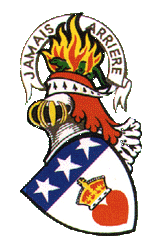Anne Douglas, Countess of Morton (c. 1610 – 15 December 1654), born Anne
Villiers, was an English noblewoman celebrated for her beauty, courage,
and unwavering loyalty to the monarchy. The 17th-century closet drama *Cicilia
and Clorinda* was dedicated to her.
Anne was the daughter of Sir
Edward Villiers (c. 1585 – 1626) and Barbara St. John, herself the
daughter of Sir John St. John. Anne was a half-niece to the Duke of
Buckingham, who was her father’s younger half-brother. Among her notable
nieces were Elizabeth Villiers, mistress of William III, and Barbara
Villiers, mistress of Charles II, who later became Duchess of Cleveland.
In April 1627, Anne Villiers married
Robert Douglas, Lord Dalkeith,
who would later inherit the title of Earl of Morton. To formalize the
union, the Duke of Buckingham pledged £5,000 and agreed to settle a
yearly income of £3,000 on Lord Dalkeith. Of this, £1,000 was earmarked
for Anne's jointure, with an additional £1,000 allocated for the
couple's expenses.
Anne and Robert had at least three children
who reached adulthood:
• William Douglas, 9th Earl of Morton
(d. 1681), who married Lady Grizel Middleton, daughter of the 1st Earl
of Middleton, and had descendants.
• Lady Anne Douglas, who in
1654 married William Keith, 6th Earl Marischal (later identified as the
7th Earl Marischal under revised nomenclature), and had descendants.
• Lady Mary Douglas, who married Sir Donald Macdonald, 10th Laird
of Sleat and 3rd Baronet, on 24 July 1662, and had descendants.
A Heroine of the Civil War
Known as Lady
Dalkeith before she became Countess of Morton, she served as godmother
to Princess Henrietta. During the Civil War, Lady Dalkeith assumed
guardianship of the infant princess, then less than one month old.
Besieged in Exeter by Parliamentary forces in April 1646, Lady Dalkeith
used her own funds to care for the child. Refusing to surrender the
princess to St James’s Palace, she embarked on a daring escape to France
to reunite the infant with her mother, Queen Henrietta Maria. Disguising
herself and the princess as peasants, Lady Dalkeith skillfully evaded
capture. During their perilous journey, the princess nearly revealed
their true identities by innocently remarking on her unfamiliar attire.
Nevertheless, they reached France safely, where Lady Dalkeith’s bravery
earned her widespread acclaim. She soon became Countess of Morton
following her father-in-law's death.
Despite efforts by Queen
Henrietta Maria and the young princess to convert her to Catholicism,
Lady Morton remained steadfast in her Protestant faith. She served as
Princess Henrietta's governess while in France, a position she held
until her husband’s death in 1651. Anne herself passed away on 15
December 1654 in Scotland, succumbing to a sudden fever.
Connections and Conflict
Anne Morton formed a
particularly close bond with Edward Hyde, 1st Earl of Clarendon, a
cousin by marriage. His letters to her often hinted at affection that
might have surpassed friendship. However, their relationship soured
after Anne accused him of meddling in her daughter Anne's marriage
plans, leading to a falling out that deeply pained Clarendon.
A
potential second marriage for Anne, to John Berkeley, 1st Baron Berkeley
of Stratton, ultimately did not materialize. Clarendon’s opposition to
the match, given his discord with Berkeley, may have played a role.
Anne’s legacy and memory were cherished by Clarendon, whose disdain for
her niece, Barbara Villiers, stemmed from his belief that she dishonored
her family. Barbara's enmity towards him contributed to his eventual
political downfall, as she sought to undermine him at every turn.
Notes:
• Earlier authors have sometimes given her name as
Elizabeth Villiers, for example Cockayne Complete Peerage vol V, p. 385
(1893) and Paul, The Scots Peerage, Vol VI p. 378 (1909). However,
according to a set of corrections for the Dictionary of National
Biography published in the Bulletin of the Institute of Historical
Research, ix, p. 138 (1931) that was not correct, and her name should be
Anne, as given for example in the Villiers pedigree in John Nichols's
Leicestershire, vol III, p. 198" (1800). This correction was duly
adopted in the second edition of the Complete Peerage, vol IX p. 296,
note e (1936), and by modern authorities including the Oxford Dictionary
of National Biography (2004) in its article "Douglas, William, seventh
earl of Morton" (doi:10.1093/ref:odnb/7933). The naming of the portraits
and early engravings (as in the collection at the National Portrait
Gallery) may be decisive, given that these are indeed likely to be of
her rather than her mother-in-law Lady Anne Keith.
Contributions
Do you have an ancestor whose
story should be told here? Please let us have the details.
Source
Sources for this article include:
Richard Ollard, (1987), Clarendon and His Friends
|


